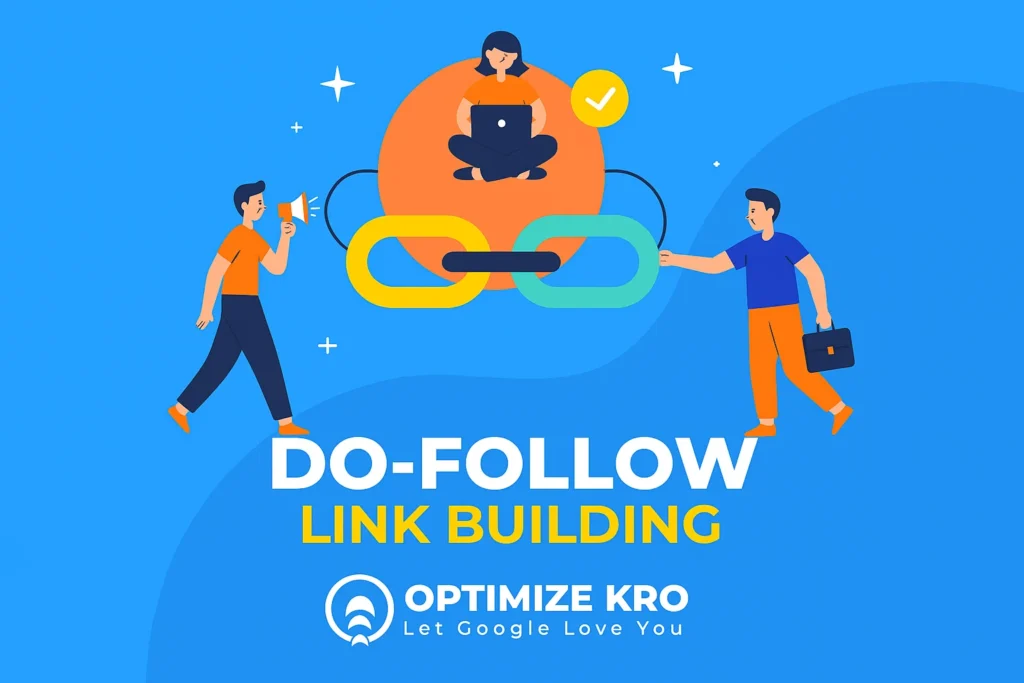Link building is an essential aspect of Off-Page SEO (Search Engine Optimization) that helps improve the authority and ranking of your website. One of the most effective ways to build links is through do-follow links. In this guide, we will cover everything you need to know about do-follow link building, including its significance, strategies, tools, and common FAQs.
Table of Contents:
- What Are Do-Follow Links?
- Why Are Do-Follow Links Important for SEO?
- How Do-Follow Links Affect Search Engine Rankings?
- Do-Follow vs. No-Follow Links
- Do-Follow Link Building Strategies
- 5.1 Guest Blogging
- 5.2 Influencer Outreach
- 5.3 Broken Link Building
- 5.4 Skyscraper Technique
- 5.5 Resource Page Link Building
- 5.6 Social Media & Forum Links
- 5.7 Directories & Citation Links
- Do-Follow Link Building Tools
- Common Mistakes to Avoid in Link Building
- How to Analyze Do-Follow Links
- FAQs on Do-Follow Link Building
1. What Are Do-Follow Links?
A do-follow link is a type of hyperlink that passes “link juice” or SEO authority from one website to another. When a website includes a do-follow link, it essentially signals search engines (like Google) to count that link as a positive vote toward the linked site’s relevance and authority.

By default, most links are do-follow unless the website owner specifies otherwise by adding a rel="nofollow" attribute to the link.
2. Why Are Do-Follow Links Important for SEO?
Do-follow links are essential for SEO because:
- Increase Domain Authority: Websites with a higher number of quality do-follow links are often perceived as more authoritative by search engines.
- Improve Organic Rankings: Search engines consider do-follow links as votes of confidence, which can help improve your rankings in the search results.
- Referral Traffic: In addition to SEO benefits, do-follow links can drive direct traffic to your site from other websites.
In summary, obtaining high-quality do-follow backlinks is a crucial strategy to enhance your website’s visibility and search rankings.
3. How Do-Follow Links Affect Search Engine Rankings?
Search engines like Google use a variety of signals to determine where a website should rank for specific search queries. Do-follow links contribute significantly to these rankings in the following ways:
- Link Equity Transfer: A do-follow link from a high-authority website to yours can pass link equity, which is beneficial for improving the rank of your web pages.
- Increased Trust and Credibility: When search engines see that reputable websites are linking to you, it boosts your site’s credibility and relevance.
- Improved Crawlability: Do-follow links help search engines crawl and index your pages more efficiently, allowing you to rank higher in relevant search queries.
4. Do-Follow vs. No-Follow Links
The primary difference between do-follow and no-follow links is the way they pass SEO value to the linked site.
- Do-Follow Links: These links pass link equity and contribute to SEO ranking.
- No-Follow Links: These links have the
rel="nofollow"attribute, which tells search engines not to pass link equity to the target site.
While no-follow links don’t contribute directly to search rankings, they can still generate referral traffic and contribute to brand visibility.
| Do-Follow Links | No-Follow Links |
|---|---|
| Pass link equity | Do not pass link equity |
| Improve SEO rankings | No effect on SEO rankings |
| Enhance trust | Helpful for brand exposure but no SEO benefit |
5. Do-Follow Link Building Strategies
Building high-quality do-follow backlinks requires a strategic approach. Here are some of the most effective link-building strategies:
5.1 Guest Blogging
Guest blogging involves writing content for another website in your industry. In return for your content, you get a do-follow backlink to your website.
Best practices for guest blogging:
- Target authoritative blogs in your niche.
- Provide high-quality content.
- Ensure the link is do-follow and placed naturally within the article.
5.2 Influencer Outreach
Reach out to influencers and bloggers in your niche and ask them to link to your content. Influencers often have strong authority and can provide valuable backlinks.
Tips for influencer outreach:
- Build genuine relationships with influencers.
- Ensure your content is relevant and beneficial to their audience.
5.3 Broken Link Building
This involves finding broken or dead links on other websites and suggesting your own content as a replacement. This provides value to the website owner and gets you a do-follow link in return.
How to do it:
- Use tools like Ahrefs or Screaming Frog to find broken links on relevant websites.
- Reach out to the site owner with a friendly email offering your content as a replacement.
5.4 Skyscraper Technique
The skyscraper technique is a strategy where you identify top-performing content in your niche, create something even better, and then ask the websites linking to the original content to link to your improved version.
Steps for skyscraper technique:
- Find high-ranking content in your industry.
- Create more comprehensive or updated content.
- Reach out to websites linking to the original content and request they link to your improved version.
5.5 Resource Page Link Building
Many websites maintain resource pages that link to valuable content in a particular industry. Find these pages and request your content to be included.
How to do it:
- Use Google search operators like “keyword + resources” to find relevant resource pages.
- Contact the website owner and ask for inclusion of your content.
5.6 Social Media & Forum Links
While social media and forum links are typically no-follow, they can still drive traffic and contribute to your overall link-building strategy. Engaging with communities and sharing your content in these spaces can help boost your SEO indirectly.
5.7 Directories & Citation Links
Submit your website to reputable directories and citation sites relevant to your business. This can help improve your local SEO and provide some do-follow backlinks.
Popular directories to consider:
- Google My Business
- Yelp
- Yellow Pages
6. Do-Follow Link Building Tools
Here are some tools that can help you with your do-follow link-building efforts:
| Tool | Description |
|---|---|
| Ahrefs | A powerful backlink analysis tool to help you find link-building opportunities. |
| SEMrush | Offers tools for competitor analysis and link-building research. |
| Moz Link Explorer | Provides an overview of your backlink profile and competitor links. |
| Majestic SEO | Specializes in link intelligence and can help track do-follow links. |
| Screaming Frog | A website crawler that can help identify broken links and opportunities. |
7. Common Mistakes to Avoid in Link Building
Here are some mistakes you should avoid when building do-follow links:
- Low-quality backlinks: Acquiring links from spammy or irrelevant websites can harm your SEO.
- Over-optimization: Too many links with the same anchor text can look unnatural and result in a penalty.
- Buying backlinks: Google does not condone buying backlinks, and this can result in a penalty if detected.
- Ignoring relevance: Ensure your backlinks are from relevant websites in your niche.
8. How to Analyze Do-Follow Links
Once you’ve built do-follow links, it’s essential to track their effectiveness. Here are some key metrics to analyze:
- Backlink Quality: Use tools like Ahrefs or Moz to assess the authority and trustworthiness of the linking site.
- Anchor Text: Ensure your anchor text is relevant and not over-optimized.
- Link Placement: Links within content (rather than in sidebars or footers) tend to be more valuable.
What Our Clients Say
Trusted by contractors and local businesses for proven Local SEO Services.
John M. – General Contractor
“These guys transformed my Google Maps ranking. More calls, more local leads, and better visibility!”
Sarah L. – Roofing Business
“Within 3 months, my business went from page 3 to the top 3 listings. Highly recommend their Local SEO service!”
David K. – Plumbing Services
“Affordable and effective SEO. My local service calls doubled in less than 90 days.”
There is no exact number of do-follow links you should aim for, but focusing on quality over quantity is key. Building a few high-quality do-follow links is more beneficial than acquiring hundreds of low-quality ones.
Having too many links at once can appear unnatural to search engines. Focus on acquiring links gradually and from reputable sources.
Most social media platforms offer no-follow links, but they still help in building brand visibility and can generate referral traffic. Use them as part of a broader link-building strategy.
Blog comments typically contain no-follow links, meaning they don’t directly impact SEO. However, they can drive referral traffic and help build relationships within your niche.
To avoid penalties, never buy links, avoid unnatural link-building practices, and always aim for quality, relevant backlinks from reputable sites.
Conclusion
Building do-follow links is an essential part of SEO that helps improve your site’s authority, visibility, and rankings. By utilizing effective link-building strategies and focusing on quality, you can significantly enhance your SEO efforts. Make sure to use the right tools to track and analyze your backlinks, and avoid common mistakes to maintain a clean link profile.

Gulfam Qamar is a seasoned Local SEO expert with a proven track record of helping businesses boost their online visibility and dominate local search results. With deep expertise in Google Business Profiles, on-page optimization, and local citation strategies, Gulfam helps brands connect with nearby customers and grow sustainably. When he’s not optimizing websites, he’s sharing actionable SEO tips and insights to empower small businesses in the digital space.

